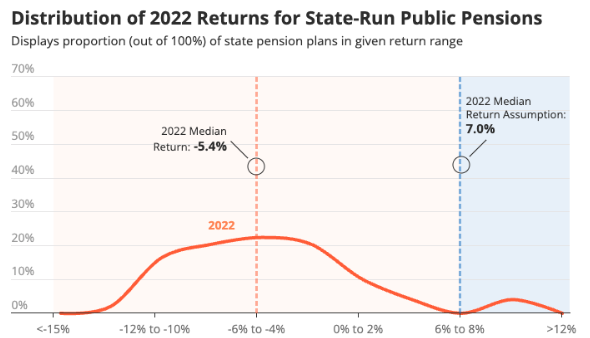This newsletter from the Pension Integrity Project at Reason Foundation highlights articles, research, opinion, and other information related to public pension challenges and reform efforts across the nation. You can find previous editions here.
In This Issue:
Articles, Research & Spotlights
- What ESG policies mean for public pension systems
- 2022 investment results for state pension plans so far
- Using hybrid retirement plans to balance risk
- Examining effective amortization policies
- Preparing public pension systems for a recession
News in Brief
Quotable Quotes on Pension Reform
Data Highlight
Articles, Research & Spotlights
Webinar: ESG Trends and Impacts on Public Pensions
The emergence of environmental, social, and governance (ESG) strategies has elicited several responses from state lawmakers, some of whom are concerned with outside interests overcoming the primary fiduciary obligations of the governments managing public pensions. In this webinar hosted by the Pension Integrity Project, former U.S. Securities and Exchange Commission Commissioner Paul Atkins, former CKE Restaurants Chief Executive Officer Andy Puzder, and Reason’s Leonard Gilroy discussed how ESG strategies impact taxpayers and public pensions. They also evaluated the types of anti-ESG laws that are emerging in various states.
You can watch the webinar here and read coverage of it at Institutional Investor and The Bond Buyer, amongst others. Here is some of Reason Foundation’s recent ESG-related analysis:
- Politics can endanger public workers’ retirement
- Democratic treasurers defend ESG investing
- The differences between individual and institutional investors considering ESG factors
- The public pension systems signing on to politicized ESG investment efforts
- The difficulties of assigning ESG ratings
The Investment Results State Pension Plans Are Reporting for the 2022 Fiscal Year
After breaking investment return records last year, most state-run pension plans are reporting significant investment losses for 2022. These losses will negatively impact unfunded liabilities and the costs of public pension plans in the coming years. The Pension Integrity Project has compiled all of the 2022 state plan investment results reported thus far, along with estimates of what these returns will mean for each plan. While there is a wide range of investment returns so far, the overall results show the median investment return for state pension systems in 2022 is -5.4%, with nearly all plans reporting returns well below what they were assuming to earn.
Best Practices in Hybrid Retirement Plan Design
A hybrid retirement plan combines the defined benefit structure commonly offered to public workers with a 401(k)-style individual account. While this is a novel concept to some, splitting retirement benefits between the two different types of plans has been a valuable way for public employers to balance the risks involved in retirement saving between the employer and employee. This policy brief by Reason’s Ryan Frost details the policies that will ensure a public hybrid plan achieves the goal of adequate retirement savings while appropriately allocating risks between all participating parties. Using examples of the federal government and states like Washington and Tennessee, policymakers can better understand the long-standing value and effectiveness of hybrid plans.
Best Practices for Pension Debt Amortization
With unfunded liabilities growing beyond $1 trillion for state and local pensions, U.S. governments have a steep hill to climb and a limited timeframe to raise the funding needed to fulfill the retirement benefits promised to public workers. Every pension plan has an amortization policy, which details how they intend to close whatever funding shortfall arises. These policies not only have a major impact on annual debt payments, they also determine how long a plan will hold expensive pension debt and how resilient it will be amidst unpredictable market outcomes. This new policy brief from the Pension Integrity Project outlines a few of the major decisions policymakers must make when it comes to the amortization of public pension plans, including the way that payments are calculated and acceptable timelines for eliminating debts.
Most State Pension Plans Are not Adequately Prepared for a Recession
The warning signs of a major recession continue to rise, which ought to be a significant concern to public pension plans. With significant levels of underfunding reported among state and local retirement plans, and too little progress made to reduce these shortfalls since the Great Recession, another economic recession would mean significant challenges for public pensions and potentially huge costs to taxpayers. Reason Foundation’s Anil Niraula and Zachary Christensen use the Teacher Retirement System of Texas to illustrate what a major recession could mean for many other public pension systems around the country. Unless policymakers make significant changes to the way governments contribute to these plans, they’ll remain especially vulnerable to periods of market turbulence.
News in Brief
New Report Indexes National Retirement Systems
Mercer and Chartered Financial Analyst (CFA) Institute’s 2022 Global Pension Index ranks retirement systems globally in terms of adequacy, sustainability, and integrity. Adequacy is evaluated by the plan design and overall benefit levels. Sustainability examines the funding levels of the plan. Integrity is understood as the regulations and protections around the plan. According to this analysis, the highest-ranking countries were Iceland, Netherlands, and Denmark. The U.S. graded around the middle of the pack, with below-average marks in “integrity.” The report acknowledges a significant drop in “adequacy” from previous years for nearly all countries, likely due to the high inflation experienced across the world. The full report is available here.
Study Finds Difference in Spending Habits from Supplemental DC Participants
A new study from the Public Retirement Research Lab examines the spending and saving habits of public employees, finding some notable differences in how those with a primary defined benefit (DB) plan and a supplementary defined contribution (DC) plan spend compared to others with standalone DB or DC plans. According to the analysis, employees who have a primary DB plan with a flexible DC supplemental option tend to spend more and save less, which could indicate a misguided level of confidence among these members. The authors suggest that this phenomenon highlights a need for better education for new members of these types of plans. The study is available here.
Quotable Quotes on Pension Reform
“The majority of investment experience for people managing money, be it asset management firms or pensions, endowments, and foundations, has been with tailwinds in the last 40 years…I would say now, the environment is that tailwind may become a headwind and is likely more challenging.”
—Los Angeles County Employees Retirement Association Chief Investment Officer Jonathan Grabel in “Are California’s Public Pension Funds Headed for Another Crisis?,” Los Angeles Times, Sept. 29, 2022
“The state will have to pay those pensions regardless if we make that return on our investments or not. If we don’t make a return on those investments, it means higher taxes for the business community and all of us. For that reason alone, we should not be doing this”
—New Jersey Business and Industry Association’s Ray Cantor on legislation to divest state pension funds from the fossil fuel industry in “N.J. Pension Fund Would Stop Investing in Fossil Fuels Under Bill Advanced Thursday,” New Jersey Monitor, Oct. 6, 2022
Data Highlight
Each month, we feature a pension-related chart or infographic of interest generated by our team of Pension Integrity Project analysts. This month, analysts Anil Niraula and Jordan Campbell created an interactive distribution of the 2022 market returns from state-run pensions reported so far. You can access the map and data here.
Contact the Pension Reform Help Desk
Reason Foundation’s Pension Reform Help Desk provides technical assistance for those wishing to pursue pension reform in their states, counties, and cities. Feel free to contact the Reason Pension Reform Help Desk by e-mail at pensionhelpdesk@reason.org.
Follow the discussion on pensions and other governmental reforms at Reason Foundation’s website and on Twitter @ReasonPensions. As we continually strive to improve the publication, please feel free to send your questions, comments, and suggestions to zachary.christensen@reason.org.
Stay in Touch with Our Pension Experts
Reason Foundation’s Pension Integrity Project has helped policymakers in states like Arizona, Colorado, Michigan, and Montana implement substantive pension reforms. Our monthly newsletter highlights the latest actuarial analysis and policy insights from our team.


